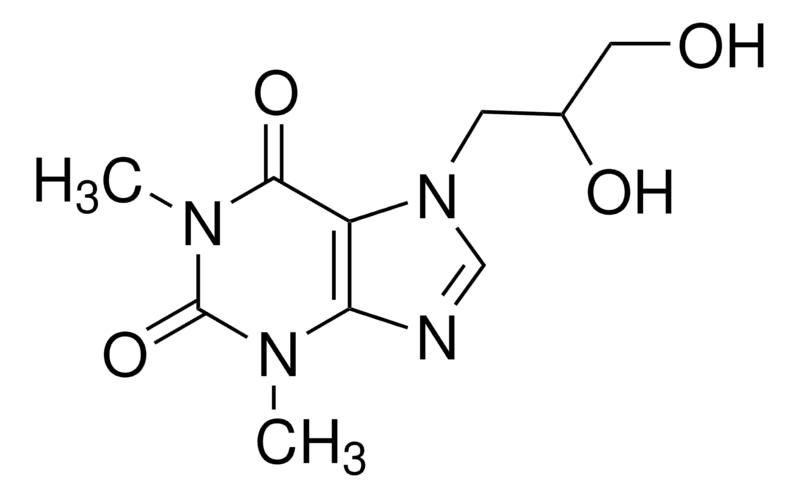Thermo Scientific™ 7-(2,3-Dihydroxypropyl)theophylline 99%
Catalog No :
CAS Number :
Brand :
In Stock
Specifications:
| Application | cell Signalling | ||
| Storage Temperature | Room Temperature | ||
| Product Type | Laboratory Chemical | Forms | Powder |
| Product Brand | Thermo Fisher Scientific™, thermo Scientific | ||
| Product Grade | Analytical grade | Formula | C₁₀H₁₄N₄O₄ |
7-(2,3-Dihydroxypropyl)theophylline, also known as Dyphylline, is a hydrophilic methylxanthine derivative of theophylline with bronchodilator properties. It relaxes bronchial smooth muscle and improves airflow in the lungs by inhibiting phosphodiesterase (PDE) and antagonizing adenosine receptors, leading to increased levels of intracellular cyclic AMP (cAMP).
Due to its enhanced water solubility compared to theophylline, Dyphylline is favored for both in vitro and in vivo pulmonary pharmacology studies. Its reduced central nervous system and cardiovascular side effects make it an ideal tool for respiratory research applications involving asthma, chronic bronchitis, and COPD.
Available Pack Sizes
| Catalog Number | Pack Size | Container Type |
|---|---|---|
| 115051000 | 100 g | Glass bottle |
| 115055000 | 500 g | Glass bottle |
Chemical and Physical Properties
| Property | Specification |
|---|---|
| Purity (Titration with HClO₄) | ≥98.5% (on dried substance) |
| Melting Point | 160–165 °C |
| Loss on Drying | ≤0.5% (1 g, at 105 °C) |
| Infrared Spectrum | Conforms to reference standard |
| Solubility | Freely soluble in water, moderately soluble in ethanol, slightly soluble in chloroform and ether |
Biological Activity
- Pharmacological Class: Methylxanthine bronchodilator
-
Mechanism of Action:
- Inhibits PDE enzymes, raising intracellular cAMP
- Antagonist at adenosine A1 and A2 receptors
-
Physiological Effects:
- Relaxes airway smooth muscles
- Reduces bronchoconstriction
- Minimizes vascular resistance in pulmonary tissues
- Induces mild diuresis and increases cardiac output (at higher concentrations)
Research Applications
Dyphylline is widely used in:
-
Pulmonary Pharmacology
- In vitro and in vivo studies of asthma, bronchitis, and chronic obstructive pulmonary disease (COPD)
- Modeling bronchodilation and respiratory smooth muscle relaxation
-
Pharmaceutical R&D
- Reference compound for formulation testing
- Assessment of solubility-enhancing strategies for methylxanthine analogs
-
Toxicology & Reproductive Health
- Explored for spermatogenic toxicity at high concentrations
- Studied for cAMP-mediated intracellular signaling pathways
-
Complex Formation Studies
- Often forms soluble 1:1 complexes with excipients (e.g., ethylenediamine) to mimic pharmacologically active salts like aminophylline
Solubility and Preparation Notes
-
Solubility Profile:
- Water: Freely soluble
- Ethanol: Moderately soluble
- Chloroform / Ether: Slightly soluble
- Aqueous acid/base (HCl, NaOH): Readily soluble
-
Formulation Tip:
Dyphylline can be used directly or converted into double salts or co-solvent formulations for enhanced solubility and delivery.
Safety and Handling
- Storage: Store at room temperature in a cool, dry place
- Handling: Avoid inhalation or skin contact; use appropriate PPE
- Stability: Chemically stable under ambient lab conditions
Thermo Scientific™ 7-(2,3-Dihydroxypropyl)theophylline (Dyphylline), ≥99% is a reliable, high-purity methylxanthine derivative widely used in respiratory, pharmacological, and biochemical research. Its superior water solubility, combined with its efficacy as a bronchodilator and adenosine receptor antagonist, make it a preferred tool for investigating airway diseases, smooth muscle physiology, and cyclic nucleotide signaling. Its robust performance across in vitro and in vivo systems supports its continued use in preclinical modeling and drug development.
- Pack Size: 100g 500g




 0
0
